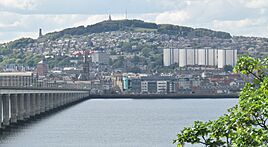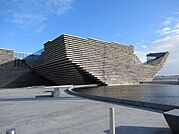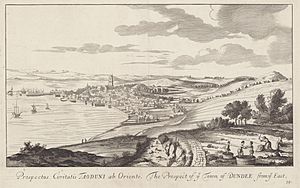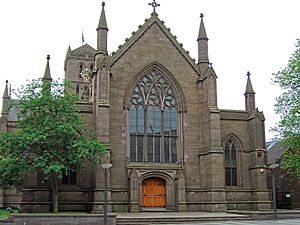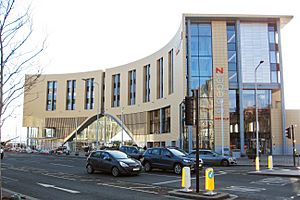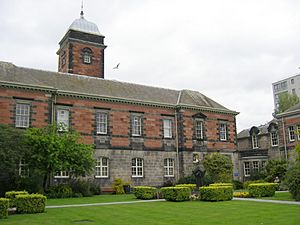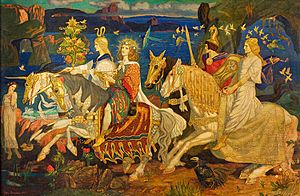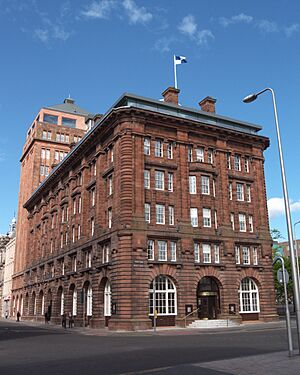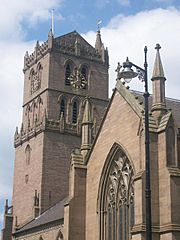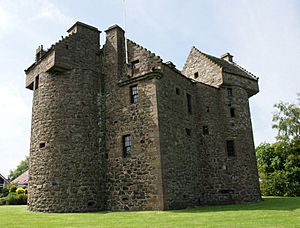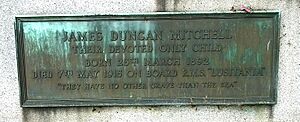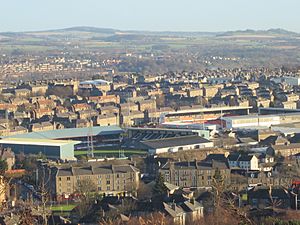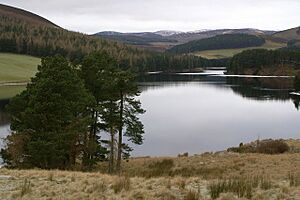Dundee facts for kids
Quick facts for kids
Dundee
Dùn Dè (Scottish Gaelic)
|
|||
|---|---|---|---|
|
City, lieutenancy and council area
|
|||
|
|
|||
|
|||
| Etymology: Dùn Dè ('Tay Fort') | |||
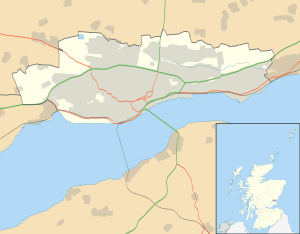
Dundee shown within Scotland
|
|||
| Sovereign state | United Kingdom | ||
| Country | Scotland | ||
| Council Area | Dundee City | ||
| Lieutenancy Area | Dundee | ||
| Founded | c. 11th century AD | ||
| Burgh charter | 1191 | ||
| City status | 26 January 1889 | ||
| Unitary authority | 1 April 1996 | ||
| Administrative HQ | Dundee City Chambers | ||
| Government | |||
| • Type | Council | ||
| • Body | Dundee City Council | ||
| Area | |||
| • Total | 20 sq mi (60 km2) | ||
| Area rank | 32nd | ||
| Population
(2022)
|
|||
| • Total | 148,350 | ||
| • Rank | 13th | ||
| • Density | 6,430/sq mi (2,481/km2) | ||
| Demonym(s) | Dundonian | ||
| Time zone | UTC+0 (GMT) | ||
| • Summer (DST) | UTC+1 (BST) | ||
| Postcode areas |
DD1–5
|
||
| Dialling codes | 01382 | ||
| ISO 3166 code | GB-DND | ||
| GSS code | S12000042 | ||
Dundee is the fourth-largest city in Scotland. It is located on the north bank of the Firth of Tay, which flows into the North Sea. The city is known for its history in industries like jute, jam, and journalism.
Dundee is also called "Dundee City" and is one of Scotland's 32 local government areas. It became an important trading port in the late 1100s. The Industrial Revolution helped Dundee grow quickly, especially in the 1800s. At that time, it was a global center for the jute industry.
Today, Dundee is working to become a cultural hub. A huge project worth £1 billion is making over the waterfront area. The V&A Dundee museum, which is the first V&A museum outside London, is a key part of this project. Dundee is promoted as "One City, Many Discoveries" because of its scientific history and the famous ship, RRS Discovery. This ship, built in Dundee, was used by Robert Falcon Scott for his Antarctic explorations.
Dundee is a major center for research and development in technology, medicine, and life sciences. It has been called a "City of the Future" and is a leader in electric vehicles. In 2014, the United Nations named Dundee the UK's first UNESCO City of Design. This was in recognition of its contributions to medical research, comics, and video games.
Contents
What's in a Name?
The name "Dundee" comes from two old Celtic words. "Dun" means 'fort', and the second part might come from a word meaning 'fire'. So, Dundee could mean 'Tay Fort'.
A Look Back in Time
Early Days of Dundee
People have lived in the Dundee area for a very long time. The city really started to grow as a seaport when William the Lion, a Scottish king, gave the land to his brother David in the late 1100s. David helped Dundee become a busy trading center.
Dundee became a Royal Burgh (a special town with rights from the king) in 1292. During the First War of Scottish Independence, English forces took over the town and its castle. But Robert the Bruce took it back in 1312.
The town faced many challenges. It was burned down by English forces in 1548. Later, during the Wars of the Three Kingdoms, it was attacked again in 1645 and destroyed in 1651. Dundee also played a part in the Jacobite uprisings. In 1689, a leader named John Graham of Claverhouse, 1st Viscount Dundee raised the Stuart flag on Dundee Law.
A famous person from Dundee was Adam Duncan. He was born in 1731 and became an admiral in the Royal Navy. In 1797, he won a very important battle against the Dutch fleet.
The 18th and 19th Centuries
In the Middle Ages, Dundee's economy was mostly about exporting raw wool. But in the 1700s, the textile industry changed with new large mills. The city also became a center for whaling. Dundee's population grew quickly, from 12,400 in 1751 to 30,500 in 1821.
A big change happened when people discovered that jute fibers could be processed using whale oil. Dundee had a lot of whale oil from its whaling industry. This made jute much cheaper than other fabrics. During the Crimean War and the American Civil War, it was hard to get flax and cotton. This made Dundee's jute industry boom.
At its peak, Dundee had 62 jute mills, employing about 50,000 workers. Many Irish workers moved to Dundee for these jobs. The city also built many ships, including the famous RRS Discovery, which is now on display in the city. Whaling stopped in 1912, and shipbuilding ended in 1981.
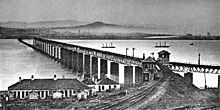
Besides jute, Dundee was known for other industries. James Keiller's and Sons, started in 1795, was the first to make marmalade commercially. The publishing company DC Thomson, which makes comics like The Beano, was founded in Dundee in 1905. This is why Dundee was known for "jute, jam, and journalism."
The city also experienced a terrible event: the Tay Bridge disaster. In 1879, the first Tay Rail Bridge collapsed during a storm, killing 75 people on a train. In 1906, a huge fire caused "rivers of burning whisky" to flow through the streets.
Dundee in the 20th and 21st Centuries
The jute industry started to decline in the early 1900s. This led to high unemployment. After World War II, new companies like NCR and Timex came to Dundee. They made things like cash registers and early computers.
Dundee was the first city in Scotland to officially become a "city" in 1889.
Today, a huge £1 billion plan is transforming the Dundee Waterfront. This project, which started in 2001, aims to connect the city center back to the river. It will also improve areas for walking, cycling, and buses. The V&A Dundee museum opened in 2018 as a major part of this plan. A new Eden Project attraction is also planned for the 2030s.
How Dundee is Run
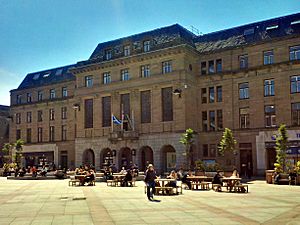
Dundee City is one of Scotland's 32 council areas. It is managed by the Dundee City Council. The council meets at Dundee City Chambers. The main leader of the council is the Lord Provost.
For national elections, Dundee is divided into two areas for the UK Parliament and three areas for the Scottish Parliament. Famous people like Winston Churchill have served as Members of Parliament for Dundee.
City History and Symbols
Dundee became a burgh between 1181 and 1195. It was made a royal burgh in 1292. The city has two mottos: Dei Donum ('Gift of God') and Prudentia et Candore ('With Thought and Purity').
Dundee was officially declared a city in 1889. Its boundaries have changed over time. For example, in 1913, it took in the nearby town of Broughty Ferry.
Voting on Independence
In 2014, Dundee was one of four areas in Scotland that voted "Yes" in the Scottish independence referendum. This meant that more people in Dundee voted for Scotland to become an independent country than to stay part of the UK.
Where is Dundee?
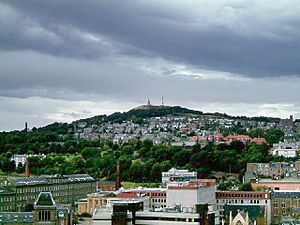
Dundee is on the north bank of the Firth of Tay, on Scotland's eastern coast. It's about 36 miles (58 km) northeast of Edinburgh. The city is shaped like a rectangle, about 8.3 miles (13.4 km) long and 2.5 miles (4 km) wide.
The city has a line of hills running through it, including Dundee Law, which is 174 meters (571 feet) high. North of these hills is a valley with the Dighty Water stream.
Two other streams, the Lochee burn and the Dighty Water, mark the city's western and eastern edges.
City Landscape
Not much of old Dundee from before the Scottish Reformation remains because of the destruction it faced. The city center used to be surrounded by walls. The coastline has changed a lot since the 1800s due to building and land being reclaimed from the river.
Many working-class homes were built quickly in the Victorian era. Living conditions were often poor. Later, planned housing estates were built to improve living standards.
Modern changes in the city center include new shopping centers and roads. The Tay Road Bridge, finished in 1966, connected the city to Fife. This new road system also separated the city center from the river.
Areas of Dundee:
- Ardler
- Balgay
- Balgowan
- Ballumbie
- Blackness
- Broughty Ferry
- Barnhill
- Camperdown
- Charleston
- City Centre
- Claverhouse
- Craigiebank
- Douglas
- Downfield
- Dryburgh
- Fintry
- Gowrie Park
- Hilltown
- Kirkton
- Dundee Law
- Lochee
- Logie
- Menzieshill
- Mill of Mains
- Ninewells
- Pitkerro
- St Marys
- Stobswell
- West End
- Whitfield
- Woodside
Dundee's Weather
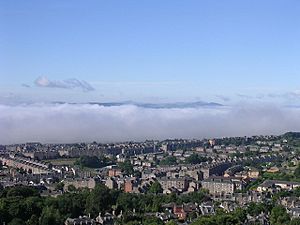
Dundee has an oceanic climate, which means it has mild winters and cool summers. The city's location by the Firth of Tay helps keep temperatures a bit warmer than other coastal areas, especially in spring and summer.
The highest temperature ever recorded in Dundee was 29.3°C (84.7°F) in July 2013. On average, the warmest day of the year reaches about 25.2°C (77.4°F). Very warm days are quite rare.
In an average year, temperatures drop to -5°C (23°F) or below about 4 to 5 days. There are also about 53 days with frost.
Who Lives in Dundee?
Population and People
Dundee's population reached its highest point in 1971 with over 182,000 people. In 2020, the city's population was estimated to be around 149,680. The largest age group in Dundee is people aged 30 to 44.
Most people living in Dundee were born in the United Kingdom, with a large number from Scotland itself. About 9% of residents were born outside the UK in 2011.
People from Dundee are called Dundonians. They often have a special way of speaking called the Scots dialect. In the 1800s, many Irish workers moved to Dundee for jobs in the textile factories. Today, Dundee has a diverse population, including many Asian residents.
Students in the City
Dundee is a popular place for university students. About one in seven people in Dundee are university students, which is one of the highest rates in Europe. Many students come from Northern Ireland and other countries around the world. These students add a lot to the city's economy and culture.
Different Backgrounds
Dundee is a city with people from many different backgrounds. In 2022, about 12.9% of people living in Dundee were born outside the UK. This number has grown over the years, showing that Dundee is becoming more diverse.
The largest groups of people born overseas in Dundee include those from Poland, India, Pakistan, and Nigeria.
Faith and Beliefs
Dundee has many different churches and places of worship. The Church of Scotland has many congregations in the area. The City Churches, Dundee Parish Church (St Mary's) and the Steeple Church, are very old and important buildings.
In the Middle Ages, Dundee had other religious buildings, but many were destroyed during the Scottish Reformation.
| Religion of Dundee residents, 2022 | ||||
|---|---|---|---|---|
| No religion | 54.6% | |||
| Christian | 33.2% | |||
| Religion not stated | 6.0% | |||
| Muslim | 4.2% | |||
| Hindu | 0.8% | |||
| Buddhist | 0.5% | |||
| Pagan | 0.5% | |||
| Other religion | 0.2% | |||
| Sikh | 0.1% | |||
| Jewish | 0.07% | |||
| Source: 2022 census | ||||
St. Paul's Cathedral is an important church for the Scottish Episcopal faith. St. Andrew's Cathedral is the main church for the Roman Catholic community in Dundee.
There are also churches for Methodists, Baptists, and other Christian groups. Muslims in Dundee have the Dundee Central Mosque and other mosques. The Sikh community has the Guru Nanak Gurdwara. There is also a Jewish synagogue, a Buddhist Temple, and a Hindu mandir.
Dundee's Economy

In the early 1900s, a large part of Dundee's population worked in the jute industry. But after World War II, the city's economy changed a lot. New companies like NCR (which made cash registers and ATMs) and Michelin (which made tires) came to Dundee.
In the 1980s, Dundee lost many manufacturing jobs. To help the economy, Dundee was made an Enterprise Zone in 1984. The first ZX Spectrum home computers were made in Dundee by Timex in 1983. However, the Timex factory closed in 1993. The Michelin tire factory also closed in June 2020.
Dundee is a major center for jobs and education in North East Scotland. Many people from nearby areas travel to work in the city. The biggest employers include NHS Tayside, Dundee City Council, and the University of Dundee. Several government offices are also based here.
The biomedical and biotechnology industries are growing in Dundee, creating many jobs. Information technology and video game development have also been important for over 20 years. Rockstar North, the company that made Lemmings and Grand Theft Auto, started in Dundee. Other game studios like Denki and Dynamo Games are also in the city.
Dundee is a key shopping destination in North East Scotland. The city center has many shops, including large department stores and smaller independent shops. There are also several retail parks outside the city center.
Getting Around Dundee
Roads and Buses
Dundee is connected by major roads like the A90 road, which goes to Perth and Aberdeen. The A92 connects Dundee to Arbroath and Montrose, and to Fife via the Tay Road Bridge.
Dundee has a large network of bus routes. Xplore Dundee runs most of the buses within the city. The Seagate bus station is the main place for buses leaving the city.
Trains, Planes, and Boats
Dundee has five railway stations, including the main Dundee railway station near the waterfront. This station was rebuilt in 2018. Train services connect Dundee to other parts of Scotland and England.
Dundee Airport offers flights to places like Heathrow Airport in London and islands like Kirkwall and Sumburgh. The airport is close to the city center. The closest major international airport is Edinburgh Airport.
The cargo port of Dundee is very important for the city's economy. It handles goods coming in and out. In recent years, more cruise ships have also started visiting Dundee. Cruises from Dundee now go to countries like Norway, Denmark, and France.
Learning in Dundee
Dundee is home to two universities and about 20,000 students. The University of Dundee became an independent university in 1967. It is known for its research in biomedical fields and has a strong law school and medical school. It also includes the Duncan of Jordanstone College of Art and Design.
Abertay University started as Dundee Institute of Technology in 1888 and became a university in 1994. It is famous for its courses in computing and creative technology, especially in computer games and cyber-security. Many successful people, including the founder of the Grand Theft Auto game series, studied here.
Dundee College merged with Angus College to become Dundee and Angus College (D&A College) in 2013. It offers further education and vocational training. There is also the Al-Maktoum College of Higher Education, which focuses on the study of Islam.
Dundee has many schools for children. There are 37 primary schools and 8 secondary schools. Some of these are Roman Catholic schools, but they welcome children of all backgrounds. There is also a special school for students with learning difficulties.
The High School of Dundee is an independent school that was founded in the 13th century. Famous people like the writer Hector Boece and, according to legend, William Wallace, were educated there.
Dundee's Culture
Dundee has tried to become the UK City of Culture and the European Capital of Culture. While it hasn't won these titles, it is known for having many cultural venues.
Museums and Art
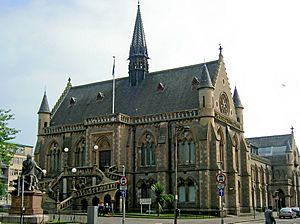
The main museum and art gallery is McManus Galleries. It has art, items from Dundee's history, and natural history exhibits. Dundee Contemporary Arts (DCA) is an international art center with galleries, a cinema, and a print studio.
The Mills Observatory is the only full-time public observatory in Britain. Dundee Science Centre has interactive exhibits about the five senses. Verdant Works is a museum about Dundee's jute industry, located in an old jute mill.
The University of Dundee also has museums and galleries, including the D'Arcy Thompson Zoology Museum and the Tayside Medical History Museum.
The V&A Dundee Museum of Design opened in 2018. It is a stunning building on the River Tay and is a major part of the city's waterfront project. It is expected to attract many visitors.
Dundee's historical records are kept at Dundee City Archives and the University of Dundee's Archive Services. These archives hold important documents about the city's past, including its industries and famous people.
Books and Stories
Dundee has a rich history of writers. Many authors were born, lived, or studied in the city, including A. L. Kennedy and Mary Shelley. The Dundee International Book Prize is a competition for new authors.
William McGonagall, often called the "world's worst poet," lived and wrote in Dundee. Many of his poems are about the city, like his famous work The Tay Bridge Disaster.
Movies and Shows
The Dundee Mountain Film Festival (DMFF) shows films about mountaineering and adventure. Dundee Contemporary Arts hosts a horror film festival called Dundead and the Discovery Film Festival for young audiences.
The city also has two large cinemas, Odeon and Cineworld.
Theatre and Dance
Dundee is home to the Dundee Repertory Theatre, which has a full-time acting group. The Scottish Dance Theatre company is also based there. The Whitehall Theatre and The Little Theatre also host performances.
Music Scene
The Caird Hall is Dundee's main concert hall and hosts the Royal Scottish National Orchestra. Dundee also has annual Jazz, Guitar, and Blues Festivals.
Dundee hosted BBC Radio 1's Big Weekend in 2006 and again in May 2023 at Camperdown Park.
Many popular music groups and musicians are from Dundee, including Average White Band, the Hazey Janes, and the View. The band Snow Patrol was formed by students at the University of Dundee.
Media in Dundee
Dundee is home to DC Thomson & Co. Ltd, a big publishing company that produces many magazines, newspapers, and comics like The Beano and The Dandy.
BBC Scotland has a broadcasting center in Dundee. STV North also has news operations in the city.
Famous Places in Dundee
The city is known for The Law, a large hill with a war memorial on top. The waterfront area has changed a lot but still has old docks. The Victoria Dock is home to the frigate HMS Unicorn and the North Carr Lightship. Captain Scott's ship, RRS Discovery, is at Craig Pier.
The oldest building in Dundee is St Mary's Tower, built in the late 1400s. It is part of the City Churches. Other important churches include the Gothic Revival St Paul's Episcopal Cathedral and the Catholic St. Andrew's Cathedral.
Because of past destruction, not many medieval buildings remain. The Wishart Arch (or East Port) is the last part of the old city walls. Gardyne's Land is another old building complex from the 1560s. The Howff burial ground was given to the city by Mary Queen of Scots in 1564.
Dundee has several castles. Mains Castle and Dudhope Castle date back to the 1500s. Claypotts Castle is a unique Z-shaped castle from the late 1500s. Broughty Castle was an important defensive structure until 1932. The ruins of Powrie Castle are also nearby.
The High School of Dundee and Morgan Academy are notable school buildings.
Many old jute mills still stand in Dundee. Some are empty, but many have been turned into new buildings. Examples include the Tay Works and Camperdown Works.
A more modern landmark is the 140-foot (43 m) Tower Building of the University of Dundee, built in the 1960s.
Sports and Fun
Football Teams
Dundee has two professional football clubs: Dundee and Dundee United. Both teams play in the Scottish Premiership. Their stadiums, the ScotFoam Stadium and Tannadice Park, are only 100 meters apart, which is closer than any other football stadiums in the UK! When they play each other, it's called the Dundee derby.
Dundee is one of only four British cities to have two teams reach the semi-finals of the European Champion Clubs' Cup. Dundee FC reached the semi-finals in 1963, and Dundee United reached them in 1984.
Ice Hockey Action
The Dundee Stars are the city's main ice hockey team. They play in the Elite Ice Hockey League, competing against teams from across the UK. They won the Gardiner Conference trophy in the 2013/2014 season. Most of their players come from Canada and the United States.
There's also an amateur ice hockey team called Dundee Rockets.
Rugby and More
Dundee has six rugby union teams. Dundee High School Former Pupils play in a high division of Scottish club rugby.
Famous athletes like Liz McColgan and Eilish McColgan, who are both runners, are from Dundee.
Other sports clubs in Dundee include handball, hockey, volleyball, and roller derby. The Olympia Leisure Centre, opened in 2013, has a swimming pool. There is also a velodrome for cycling called Caird Park Velodrome.
City Services
Scottish Water provides water to Dundee from reservoirs like Lintrathen and Backwater. Electricity is supplied by Scottish Hydro Electric.
Dundee City Council handles waste management. There's a recycling program that collects cans, glass, plastic bottles, and paper. Recycling centers are available across the city.
Police Scotland provides law enforcement, with headquarters in West Bell Street and several police stations.
Healthcare is provided by NHS Tayside. Ninewells Hospital is the main hospital with an emergency department. The Scottish Ambulance Service covers Dundee and the surrounding areas.
The Scottish Fire and Rescue Service has three fire stations in the city.
Friendly Cities Around the World
Dundee has "sister city" relationships with several cities around the world:
- Orléans, France (1946)
- Zadar, Croatia (1959)
- Alexandria, United States (1962)
- Würzburg, Germany (1962)
- Nablus, Palestine (1980)
- Dubai, United Arab Emirates (2004)
- West Dundee, United States (2013)
Special Honors for Dundee
The "Freedom of the City" is a special honor given to people and military groups. Here are some who have received it in Dundee:
Individuals
- William Arrol: 1889
- Henry Morton Stanley: 1890
- William Harcourt: 1898
- Sir John Leng: 1902
- Whitelaw Reid: 1906
- H. H. Asquith: October 1912
- Emma Grace Marryat: 1918
- David Middleton Greig: 1920
- Agnes Husband: 1926
- Thomas Johnston: 1947
- Queen Elizabeth The Queen Mother: 1954
- Maurice McManus: 1981
- Nelson Mandela: 9 October 1993
- Aung San Suu Kyi: 2008
- Ramsay MacDonald
- Stanley Baldwin
- Rev. William Macmillan
- James McLean
Military Units
- The Black Watch (Royal Highland Regiment): 1954
See also
 In Spanish: Dundee para niños
In Spanish: Dundee para niños
- Brittle Bone Society, a UK charity established in 1968 in Dundee
- Dundee Museum of Transport
- History of Dundee#Notable Dundonians and people associated with Dundee
- Alexander C. Lamb and references to the Lamb Collection, which is held in the City Museum and the Local History Centre of Dundee Central Library


